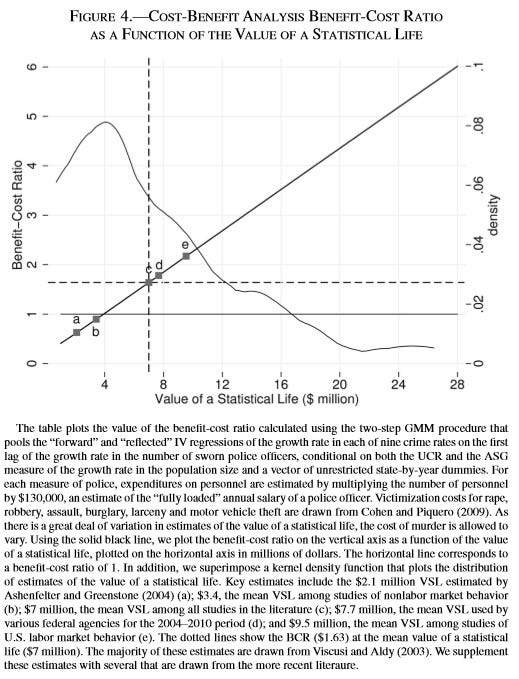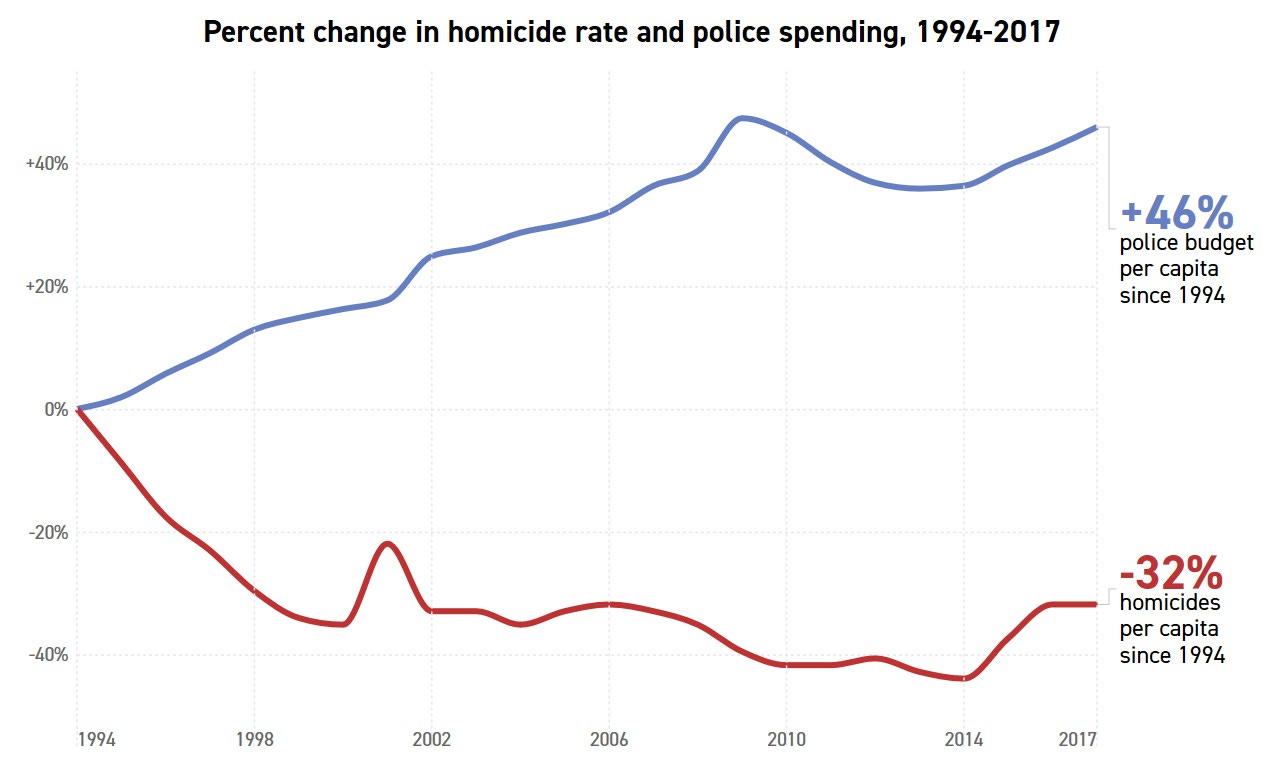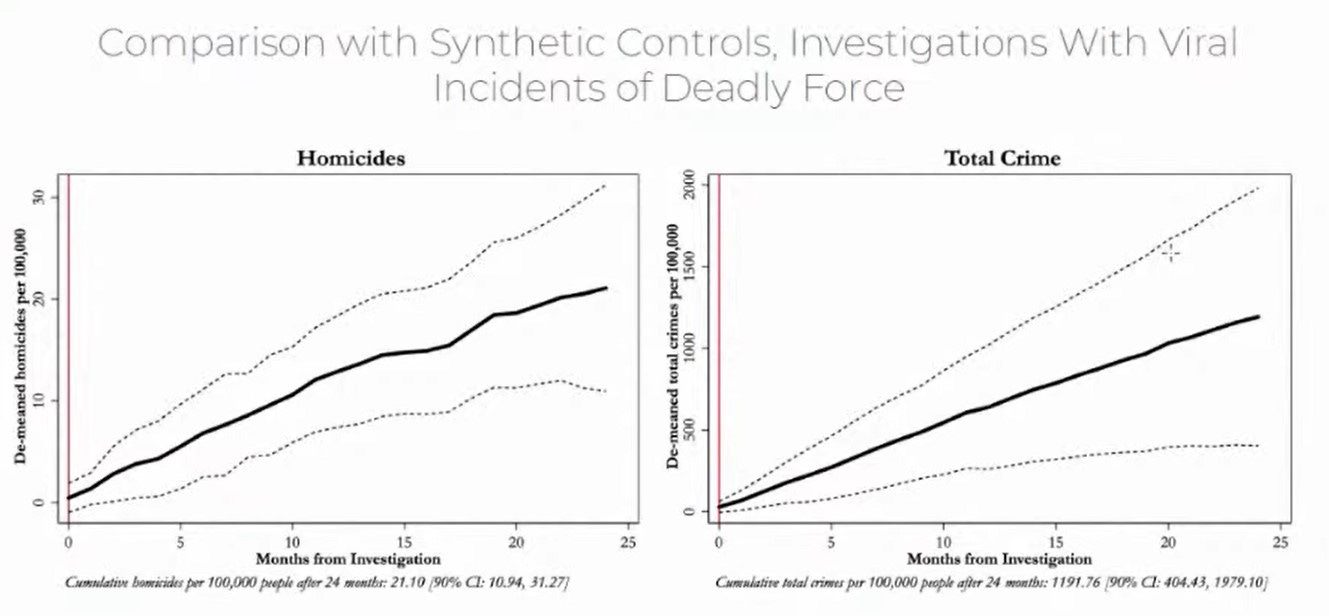Police, of course, serve an essential role in preserving order, so people can go about their lives in peace. Ibram X. Kendi has stated that “When it comes to defunding the police, many Americans have historically supported inflated police budgets on the premise that it’s police who are able to bring down crime levels. But there’s no data that supports that.” But that’s false. A variety of studies have concluded as follows:
“As of 2010, the [implied Wald] estimate is that one additional sworn officer reduces victimization costs by $310,000.”
“Combining these estimates with the social welfare approach we outline suggests that increases in police in medium to large U.S. cities in recent years would have substantially improved social welfare. We estimate that as of 2010 in our study cities, a dollar invested in policing yields a social return of $1.63.”
“I find that an increase in police presence significantly reduces crime on the margin, with elasticities of −1.28 for violent crime and −0.73 for property crime. … [T]his study demonstrates that police hiring substantially reduces serious crime.” (In economics, elasticity is the measurement of the percentage change of one economic variable in response to a change in another.)
As Politico reported:
Studies have shown that an increase in sworn police officers reduces instances of crime. … Research suggests reducing crime depends less on a police department’s total budget than on how they choose to spend it. Aaron Chalfin, an assistant professor of criminology at the University of Pennsylvania’s Department of Criminology, has found that a higher number of sworn police officers can lead to a reduction in violent crime. “A lot of this depends on what the police do,” he said. “If you were to reduce the size of the police force, and you had way fewer officers, the available data tell us that that's a risk, because police manpower does have an effect on crime, particularly violent crime.”
As summarized at Vox:
Solid data suggests that even if you take a realistic view of the police, spending money to hire more police officers — an idea espoused by both Presidents Bill Clinton and Barack Obama — is a sound approach to the multifaceted problem of criminal justice. More police officers, in particular, doesn’t need to mean more arrests and more incarceration. More beat cops walking the streets seems to deter crime and reduce the need to arrest anyone.
On the flip side, evidence shows that when police retreat or are reluctant to enforce the law, crime rises. Harvard social scientist Roland Fryer has recently found that when police departments are investigated by the federal government following incidents of the excessive use of force by a police officer that happen to go “viral” on the internet, those police departments reduce their interaction with their communities, such that homicides are allowed to go up in those communities, costing 1,000 (mostly black) lives over a 24 month period in the studied cities.
In response to anti-police protests, police are retiring and resigning in large numbers. As reported in the New York Times:
A survey of almost 200 police departments indicated that retirements were up 45 percent and resignations rose by 18 percent in the year from April 2020 to April 2021 when compared with the previous 12 months, according to the Police Executive Research Forum, a Washington policy institute. New York City saw 2,600 officers retire in 2020 compared with 1,509 the year before. Resignations in Seattle increased to 123 from 34 and retirements to 96 from 43. Minneapolis, which had 912 uniformed officers in May 2019, is now down to 699. At the same time, many cities are contending with a rise in shootings and homicides. Asheville was among the hardest hit proportionally, losing upward of 80 officers, more than one third of its 238-strong force.
As Heather MacDonald reports, after the 2020 riots protesting the death of George Floyd, “The year 2020 likely saw the largest percentage increase in homicides in American history. Murder was up nearly 37% in a sample of 57 large and medium-size cities. Based on preliminary estimates, at least 2,000 more Americans, most of them black, were killed in 2020 than in 2019.”
From 2014 to 2019, researcher Travis Campbell tracked more than 1,600 Black Lives Matter protests across the country, largely in bigger cities, with nearly 350,000 protesters. His main finding is a 15 to 20 percent reduction in lethal use of force by police officers — roughly 300 fewer police homicides — in census places that saw BLM protests. But Campbell’s research also indicates that these protests correlate with a 10 percent increase in murders in the areas that saw BLM protests. That means from 2014 to 2019, there were somewhere between 1,000 and 6,000 more homicides than would have been expected if places with protests were on the same trend as places that did not have protests. (Campbell’s research does not include the effects of the summer of 2020’s historic wave of protests because researchers do not yet have all the relevant data.
Finally, a paper published in 2022 in the American Economic Review found a very large decrease in policing following highly publicized use of force by the police. As the authors write:
We find that following George Floyd's death, arrests and police-initiated calls decreased by 62 and 69 percent, respectively. By comparison, arrests and police-initiated calls decreased by 3 and 1.5 percent following police-involved shootings. We conclude that incidents of police violence generate "de-policing," and the effect is much larger following highly publicized incidents.











